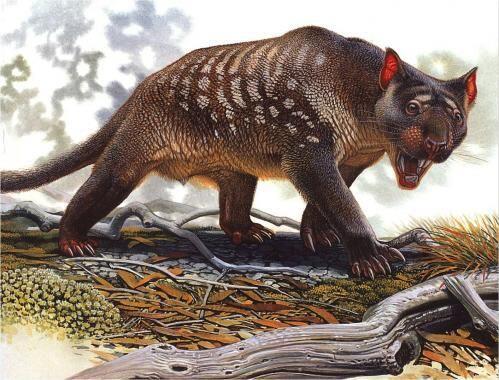Australia was home for about two million years of the marsupial lion (Thylacoleo carnifex) that are extinct 30,000 years ago. This species, described as one of the most destructive predatory beasts, belonged to the same order as kangaroos and koalas, although resembling in physical and in size to a large jaguar (Panthera onca) today.
This hunter was able to take down much larger than him, like kangaroos or diprotodon -the largest marsupial that ever existed-something greater than a white rhino sized herbivores.
Until now it was unknown how this animal with late Peistoceno kill their prey, because unlike the big cats, this carnivore lacked large canines with which pierce their prey.
New research, published in the journal Paleobiology, reveals that the marsupial lion had his weapon of destruction in his elbows and claws, and not in his jaw, as in the rest of predators. The authors, researchers from the universities of Malaga and Bristol (UK), compared fossils of this extinct species elbows of other mammals.
While specialized climbing animals such as orangutans, have a joint adapted for easy maneuverability of the forearms, other species such as dogs, specialized in the race, have joints that restrict the movement back and forth.
In the case of big cats such as tigers, they have an intermediate elbow mobility that allows them both to have stability on the ground as a range of motion to deal with their prey.
“Surprisingly, elbow marsupial lion, despite its similarities to the great felinos- allow a rotation of the forearm and hand, as if it were an arboreal mammal, but with additional features that allow a large consolidation of member on the ground, “explains Christine Janis, a researcher at Britain’s university and one of the study’s authors.
In addition, he sported a huge retractable claw, similar to cats but much larger, and semioponible thumb allowing better management of the dam.
The authors concluded that, unlike an actual lion keeps its prey with its claws and kills her with his teeth, the marsupial lion used his teeth to keep their prey and their huge claws to end it .
Marsupial lion incisors robustos- -desafilados and worked as gripping and holding of the dam and not to pierce the prey with a deadly bite.
Tormentor, executor, murderer and butcher
“The marsupial lion keeps surprising since a century ago the great anatomist Sir Richard Owen first described their fossil remains by the epithets for torturer, executioner, murderer and butcher” says Borja Figueirido, a researcher at the University of Malaga and coauthor of the study. “Now his skeletal anatomy reveals that his elbow joint combines a very peculiar ability to perform pronation-supination movements while he makes up much stability to the entire forelimb”.
In other words, his elbow anatomy reveals great similarities with the current arboreal species but with clear adaptations to a way of life on Earth. This ability to move, in combination with a semioponible thumb and with a highly developed claw, suggests to the authors that the animal could have arranged a unique arsenal in the predatory behavior of existing carnivores, where his thumb had a role much more active in hunting, perhaps even becoming the main weapon to kill their prey.
“This evidence changes the knowledge about the ‘battery’ behaviors hunting known in the Carnivora order until today and reveals the importance of knowing the historical dimension of life on earth, that is, of Paleontology” says Figueirido.
Meanwhile, Alberto Martin Serra, also of the University of Malaga and third author of the paper concludes: “Being able to deduct such unique behavior through a part of the skeleton is very important because it expands the possibilities in the study of life in the past, which is no longer limited to simple comparison with existing bodies “.











